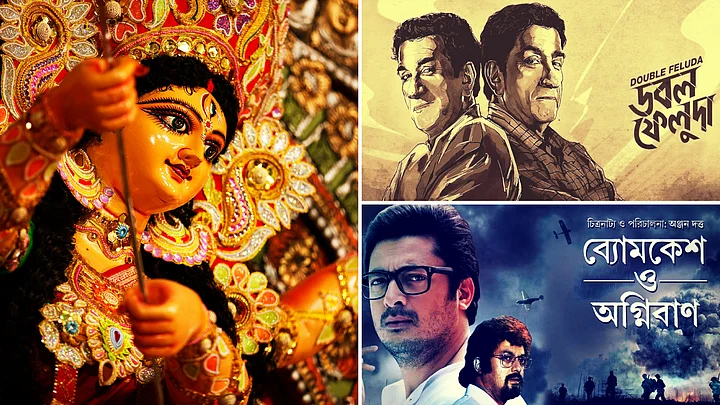Funnily, it’s hard to remember a single Pujo in 27 years when someone didn’t mention Feluda. Feluda – that forever-28-year-old Charminar-smoking extoller of the magaj (mind) over maar (blows). Or Byomkesh, Feluda’s literary (and often cinematic) compeer, matching magaj astra for magaj astra, exchanging the trousers for a dhoti, but equally poised to take over the Bangalee imagination. An imagination that is, often, already fired by the sound of a million dhaaks in a million makeshift bamboo homes.
But where do a bunch of sleuths – working in a world of no cellphones – fit into the scheme of Bengal’s largest festival, year after year?
The Cinema
It’s hard to dissociate the Bangalee from the goyenda (private detective) and the goyenda from the Pujo – an inexplicable chain seeming to link the three for eons now. Sample this, for instance. In the last three years (2015, 2016 and 2017), three Byomkesh movies have been filmed and released with deliberate precision, hitting halls less than a week before Pujo and riding on wearied pandal-goers who’d like their popcorn metres within the last pandal stop, thank you very much.
But why is a goyenda movie the go-to Durga Pujo release?
Sure, the Khans of Bollywood have each allotted themselves a festival in the Indian calendar – I mean, what’s a Diwali without Shah Rukh or an Eid without Salman Bigg Boss Khan? – but these are grandiose preparations of masala extravaganza. More often than not, they bank on a wave of festival gladness, presenting inspired offerings such as Happy New Year and Ra One. A Byomkesh or a Feluda would hardly stand for such frivolity – in, fact, they make the strongest claim to your own magaj! Then why do they chase Pujo dates, year after year?
2015’s super-successful Byomkesh Bakshi made way for 2016’s equally successful Byomkesh O Chiriyakahana, tying things up in a neat hattrick bow with last month’s Byomkesh O Agniban.
In an interview to Hindustan Times in 2016, (Feluda creator) Satyajit Ray’s son Sandip Ray – who has unflinchingly taken on the mantle of recreating Feluda on screen from his father – spoke of wanting a double Feluda release around the festival. “I’ll be happy if Double Feluda releases this Durga Puja”, he gushed, ultimately managing to push out the film only in December.
Funnily enough, yet another goyenda film – Yeti Obhijan (featuring yet another famous Bengali literary detective, Kakababu) – was slated for release in December this year, but was rushed for a Pujo release this year.
What spurs this choice to watch a grimy alleyway and a half-lit north Kolkata home over glitz and glitter during Pujo?
Nostalgia, perhaps, is a stronger reckoning call than many would account for.
The Books
Director Dibakar Banerjee, in a post published in The Telegraph around Pujo 2014, seems to sum it up when he writes:
I think what surpassed everything else was that (Puja) was the time for a new Feluda and Byomkesh. We would wait eagerly for the books since some of the best writers — from Tagore to Bibhutibhushan Bandopadhyay — used to be featured for kids. So for me Pujas meant a new set of adventure, detective or thriller books. The rohosyo romancho (thriller) series were still there and we used to pore over books such as Dakat Barir Jongole and Chhaya Kalo Kalo.Dibakar Banerjee, Post published in The Telegraph.
Truth is, a lot of Bangla literature published around Pujo were Feludas, Byomkeshes, Kakababus and their popular ilk.
Even if it wasn’t freshly published literature, a large amount of ‘young adult’ literature’ was read around the Pujo holidays – literature made up of the famous detectives, Bengali translations of Tintin and Asterix and endearing Bengali comic characters like ‘Nonte-Fonte’.
A Bengali child’s vacations can be neatly divided into summer, Pujo and winter vacations – thus standing to reason that a vast amount of voracious reading was done during Pujo, when kids could expect a reprieve from timetables.
As a particularly petulant 12-year-old who failed three math exams in succession for sneaking in a comic book behind a textbook, I can remember Pujo holidays where schoolbags were cheerfully shoved out of eyesight. Amazingly, so can my mother. “You didn’t know Pujo had arrived until you laid your hands on a Pujobarshiki,” she reminisces. “Reams and reams of print dedicated to the latest mystery short story – we couldn’t be forced to go outdoors!”
A perusal of old Pujobarshiki covers (quite literally, magazines published during the time of Durga Pujo every year) threw up the delightful marriage between fiction and festival.
This one above, for instance, published in 2005, depicts a crowd made up of Tintin, Captain Haddock, Feluda and his faithful nephew Topshe, Kakababu and Phantom – among others – looking up interestedly at a shadowy figure of Durga Maa.
This other one, above, published earlier in 2003, shows the same old crew getting off a plane – possibly to begin their own Pujo holidays!
Point is, detective fiction and the Bangalee – and the Bangalee and Pujo – have been inextricably linked for eons now. The spate of goyenda successes on celluloid, therefore, shouldn’t be surprising. Someone finally connected the dots between nostalgia and commercial success. And if you’re a nostalgia-loving, magaj-adventure-hungry Bangalee, you’ve found a win-win.
